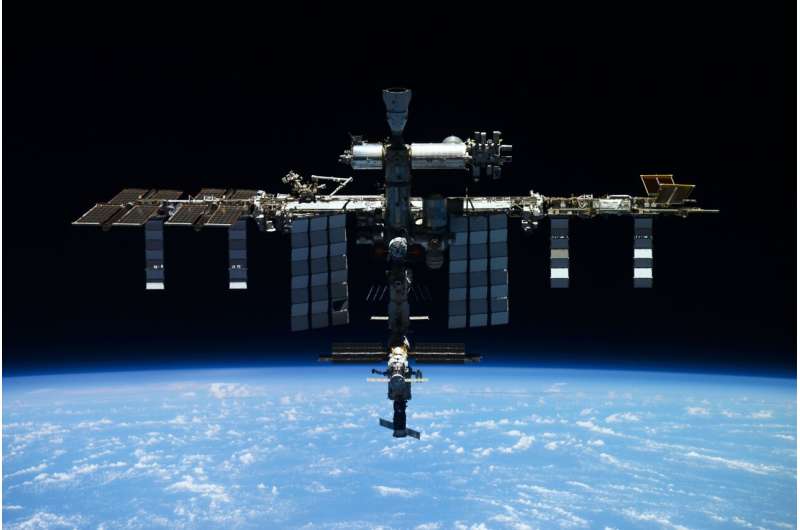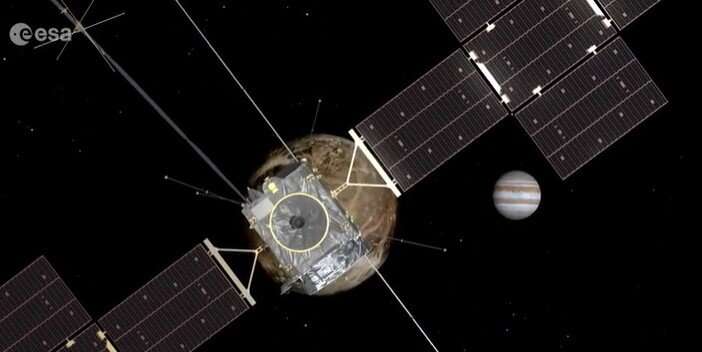New models shed light on life's origin
Monday, 13 February 2023 03:36 The first signs of life emerged on Earth in the form of microbes about four billion years ago. While scientists are still determining exactly when and how these microbes appeared, it's clear that the emergence of life is intricately intertwined with the chemical and physical characteristics of early Earth.
"It is reasonable to suspect that life could have started differently-or not at all-
The first signs of life emerged on Earth in the form of microbes about four billion years ago. While scientists are still determining exactly when and how these microbes appeared, it's clear that the emergence of life is intricately intertwined with the chemical and physical characteristics of early Earth.
"It is reasonable to suspect that life could have started differently-or not at all- Can you spot it
Monday, 13 February 2023 03:36 Right in the middle of this image, nestled amongst a smattering of distant stars and even more distant galaxies, lies the newly discovered dwarf galaxy known as Donatiello II. If you cannot quite distinguish the clump of faint stars that is all we can see of Donatiello II in this image, then you are in good company.
Donatiello II is one of three newly discovered galaxies that were so diffi
Right in the middle of this image, nestled amongst a smattering of distant stars and even more distant galaxies, lies the newly discovered dwarf galaxy known as Donatiello II. If you cannot quite distinguish the clump of faint stars that is all we can see of Donatiello II in this image, then you are in good company.
Donatiello II is one of three newly discovered galaxies that were so diffi AccelerComm, TTP set to soar with 5G NTN LEO Space Cell
Monday, 13 February 2023 03:36 AccelerComm, the 5G IP specialists, has partnered with UK-based technology development firm TTP to jointly develop a 5G LEO Regenerative base station designed for deployment on low-earth orbit (LEO) satellites. The project combines expertise and IP from the two companies, along with additional technology from partners, to offer a dedicated 5G regenerative gNodeB solution optimized for use in a N
AccelerComm, the 5G IP specialists, has partnered with UK-based technology development firm TTP to jointly develop a 5G LEO Regenerative base station designed for deployment on low-earth orbit (LEO) satellites. The project combines expertise and IP from the two companies, along with additional technology from partners, to offer a dedicated 5G regenerative gNodeB solution optimized for use in a N Women and girls in science: the team helping to take us to Mars
Monday, 13 February 2023 03:36 ESA celebrates the International Day of Women and Girls in Science? this 11 February, and highlights the story of the first all-female Systems Team in ESA's Concurrent Design Facility, the place where ideas for new space missions, systems and structures take definite shape.
Meet the team behind the Mars Transit Habitat study that will be the backbone for sustainable roundtrips to Mars.
ESA celebrates the International Day of Women and Girls in Science? this 11 February, and highlights the story of the first all-female Systems Team in ESA's Concurrent Design Facility, the place where ideas for new space missions, systems and structures take definite shape.
Meet the team behind the Mars Transit Habitat study that will be the backbone for sustainable roundtrips to Mars. Antaris launches cloud-built satellite JANUS-1 onboard India's SSLV-D2
Monday, 13 February 2023 03:36 Antaris, creator of the most advanced software platform for space, has announced that the world's first satellite fully conceived, designed and manufactured using the company's end-to-end cloud platform has successfully reached orbit.
JANUS-1 rode on the Indian Space Research Organization's (ISRO) SSLV-D2 rocket, which was launched from the Satish Dhawan Space Centre of India under a comme
Antaris, creator of the most advanced software platform for space, has announced that the world's first satellite fully conceived, designed and manufactured using the company's end-to-end cloud platform has successfully reached orbit.
JANUS-1 rode on the Indian Space Research Organization's (ISRO) SSLV-D2 rocket, which was launched from the Satish Dhawan Space Centre of India under a comme Chinese astronauts complete first walk outside Tiangong space station
Monday, 13 February 2023 03:36 A crew of Chinese astronauts on a six-month mission aboard the country's newly completed space station ventured outside the orbiter for the first time Friday for what became a successful spacewalk.
Chinese astronauts Fei Junlong and Zhang Lu donned the puffy white space suits and exited the station to conduct the 7-hour walk, while the third astronaut, Deng Qingming, stayed behind to mo
A crew of Chinese astronauts on a six-month mission aboard the country's newly completed space station ventured outside the orbiter for the first time Friday for what became a successful spacewalk.
Chinese astronauts Fei Junlong and Zhang Lu donned the puffy white space suits and exited the station to conduct the 7-hour walk, while the third astronaut, Deng Qingming, stayed behind to mo NanoAvionics doubles overall production capacity with MAIT expansion
Monday, 13 February 2023 03:36 Kongsberg NanoAvionics (NanoAvionics), a small satellite mission integrator and bus manufacturer, has recently opened its manufacturing, assembly, integration, and testing (MAIT) facility in Vilnius, Lithuania.
This expansion to the company's existing facilities in Lithuania (HQ), the UK, and the USA has doubled its satellite production capacity, allowing it to meet the growing demands for
Kongsberg NanoAvionics (NanoAvionics), a small satellite mission integrator and bus manufacturer, has recently opened its manufacturing, assembly, integration, and testing (MAIT) facility in Vilnius, Lithuania.
This expansion to the company's existing facilities in Lithuania (HQ), the UK, and the USA has doubled its satellite production capacity, allowing it to meet the growing demands for Russian spacecraft leaks coolant, station crew reported safe
Sunday, 12 February 2023 19:32
An uncrewed Russian supply ship docked at the International Space Station has leaked coolant, the Russian space corporation and NASA reported Saturday, saying the incident doesn't pose any danger to the station's crew.
Launch demand remains high despite industry struggles
Sunday, 12 February 2023 13:13
Despite concerns about the viability of many new launch vehicle developers, many in the industry say those vehicles are needed as demand for launch outstrips supply.
Plasmos unveils Space Truck
Sunday, 12 February 2023 01:27
Plasmos plans to offer in-space transportation and return payloads to Earth with a Space Truck.
The post Plasmos unveils Space Truck appeared first on SpaceNews.
White House reviewing input on mission authorization concepts
Saturday, 11 February 2023 23:42
The National Space Council is continuing work on a proposed framework for regulating commercial space activities that is being watched closely by both industry and Congress.
Progress cargo spacecraft at ISS suffers coolant leak
Saturday, 11 February 2023 16:40
A Progress cargo spacecraft docked to the International Space Station experienced a coolant leak Feb. 11, the second such incident involving a Russian spacecraft at the station in less than two months.
Lunar cubesats encounter technical problems
Friday, 10 February 2023 23:02
One NASA-funded lunar cubesat has recovered from a communications glitch while engineers are developing backup plans for another cubesat that has suffered a propulsion problem.
Inmarsat remains open to ordering its own LEO constellation
Friday, 10 February 2023 21:51
Inmarsat says it is still considering deploying a low Earth orbit constellation of its own despite comments to the contrary by one of its executives this week.
Juice's odyssey of exploration: Jupiter's icy moons
Friday, 10 February 2023 17:45
A grand odyssey of exploration is about to begin. Humankind's next bold mission to the outer solar system, ESA's Jupiter Icy Moons Explorer, Juice, is poised to explore giant planet Jupiter and its largest moons. These intriguing worlds have piqued our curiosity ever since Galileo first raised his telescope to the planet and discovered its four largest moons: Io, Europa, Ganymede and Callisto, three of which are thought to harbor underground oceans.
Early space probes visiting the Jovian system have raised more questions than answers. But thanks to Juice, many of those answers are now within reach. ESA is launching the spacecraft in April 2023 on an eight-year journey to the distant planet.
To uncover the hidden secrets of these mysterious worlds, Juice is equipped with the most powerful science instruments ever sent to the outer solar system. The spacecraft will face many dangers along the way: radiation, extreme temperatures, and the vast gravitational pull of Jupiter, all while operating hundreds of millions of kilometers from Earth. But in the safe hands of ESA's operators to guide it safely through these challenges, the dangers will be worth it for the science that Juice is destined to uncover.

